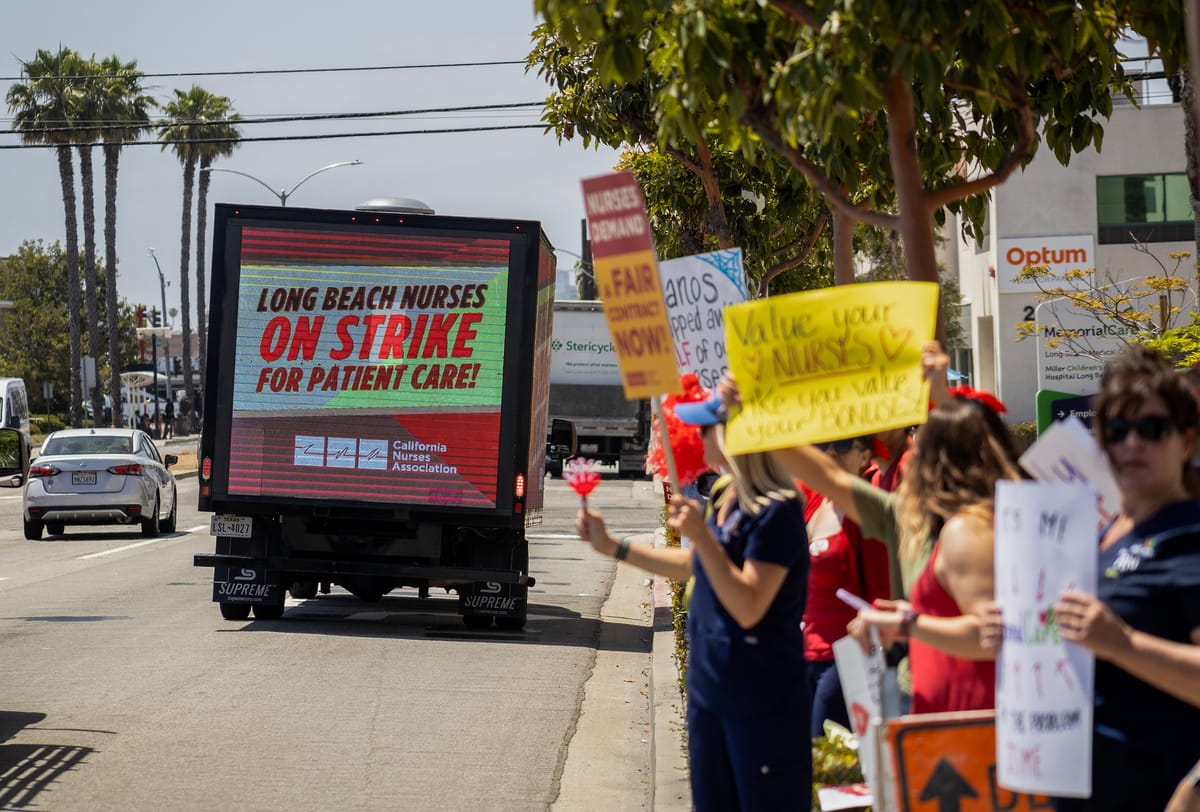Long Beach Memorial nurses on strike for 1st time in 15 years
The one-day strike will be followed by a four-day lockout by the hospital.

Car and truck horns blare as they drive past MemorialCare’s Long Beach medical campus on Atlantic Avenue. The street is lined with nurses waving colorful signs proclaiming that they are on strike — an action not taken at the hospital since 2010.
The California Nurses Association, which represents more than 2,100 nurses at Long Beach Medical Center and Miller Children’s and Women’s Hospital, announced the one-day strike on May 8. Hospital leadership quickly responded by announcing an additional four-day lockout.
“This fight is tough,” Brandy Welch, a registered nurse and member of the bargaining team, said during Thursday's demonstration. “We have an employer who does not respect us.”
Hospital management, meanwhile, says the opposite: “We care about [our nurses], we respect them and we want to get them back at the bedside,” Abbey Herrera-Williams, vice president of human resources at the hospital, told the Watchdog Thursday.
Contract negotiations began Feb. 5, with the old contract expiring at the end of March. Since then, 15 bargaining sessions have taken place. A 16th was scheduled for May 9, but was cancelled by management due to the strike announcement.
The hospital, for its part, says the strike is premature since there have not been enough bargaining sessions to really get into the issues. Management offered additional sessions in May and June if the union withdrew the strike notice, which the union refused to do.

“We had to prepare for the strike,” Herrera-Williams said. “In order to do that, we can’t be at the bargaining table.”
Preparations for the strike included contracting an undisclosed number of high-paid traveling nurses, increasing security and adjusting procedures for how employees are allowed to enter the facility. All the measures, according to the hospital, have allowed patient care to continue uninterrupted.
According to an internal memo obtained by the Watchdog, the increased security includes restricting staff entry to certain areas, with every employee required to check in; additional public safety personnel, who will provide escorts upon request; and a Long Beach Police Department presence.
“Any form of bullying or retaliation will not be tolerated,” the memo reads.

One of the demands being made by nurses is the need for additional security measures for the safety of staff and patients alike. The union says the hospital is not giving any ground to its requests in that area.
“But there’s plenty of security today,” said Haley Harter, a registered nurse at Miller Children’s.
While there is a weapon detector at the emergency room entrance, Harter noted no other entrances on the busy campus have them. Nurses have reported seeing people with machetes and guns in the facility. In 2009, a gunman killed two people inside the hospital before turning the gun on himself.
“It’s unacceptable,” Harter said, adding that she has found herself in unsafe situations in her two years at the facility — first in the adult cardiac ICU and now in the pediatric cardiac ICU.
“People that are having their worst day, being told their loved one is dying, being told there’s nothing we can do — the stress, the anxiety is there, and it’s our job as nurses to care for that family,” Harter said. “I’ve had family members get in fights with other family members. But when I'm trying to keep somebody alive, the last thing I need in that little, cramped room is five adults arguing, screaming, yelling, fighting. It’s not safe for me but I can’t leave the room because my patient needs me. So I’m scared and panicked in a corner just waiting for security or my other nurses to come and intervene.”
The hospital takes staff and patient safety “very seriously,” according to Stephanie Garcia, vice president of operations and a registered nurse.
“We’re constantly evaluating our security measures,” Garcia said, adding that the hospital will comply with state law requiring weapons detectors at all entrances by January 2027. “It is something that we as an organization are always looking to improve.”
In addition to security concerns, the union is pushing for better nurse-to-patient ratios, which have a direct impact on patient care and outcomes. Harter noted that many units will be staffed by “floating” nurses, which provides the numbers, but with skills that often don’t align for the best patient care.

For example, Harter noted that a nurse with specialized training in neonatal care may float to a unit and find themselves caring for a teenager with asthma without the necessary training.
“Yes, there’s a nurse filling that position,” Harter said. “But is that safe staffing just because it’s a number?”
In the emergency room, which does not require the level of specialized training of other units, Harter said the number is the issue. Too few nurses results in hours-long waits for patients, Harter said, which in turn can worsen their condition and even delay necessary procedures if an infection forms.
“We can’t keep bleeding nurses anymore so that the C-suite can make all that money,” Singrid Steinmetz, a registered nurse in the ICU and chief nurse representative, said Thursday.

While the nurses rally for increased staffing to appropriately care for patients, the hospital has reportedly been struggling financially, allegedly facing a $40 million budgetary shortfall. As a result, the strike comes on the heels of the hospital laying off 175 workers, including dozens of nurses, over the span of two months.
In an internal memo, interim CEO Frank Bierne said the strike will only exacerbate the situation by costing the hospital millions of dollars. He said the loss will “dramatically” reduce the wages and benefits management can offer nurses in upcoming contract proposals.
“When I first started becoming aware of these systemic issues in the hospital, I was sad,” Harter said. “But now I'm mad. It's so blatant what they're doing. They're not taking care of us, they're not taking not taking care of the patients and, at the end of the day, they don't care.”
We need your support.
Subcribe to the Watchdog today.
The Long Beach Watchdog is owned by journalists, and paid for by readers like you. If independent, local reporting like the story you just read is important to you, support our work by becoming a subscriber.





